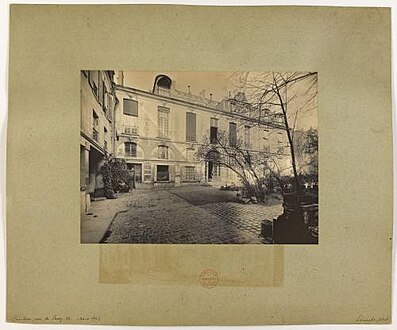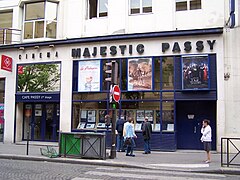Rue de Passy
Coordinates: 48 ° 51 ' N , 2 ° 17' E
| Rue de Passy | |
|---|---|
| location | |
| Arrondissement | 16. |
| quarter | Muette |
| Beginning | Rue de Boulainvilliers |
| The End | Place du Costa Rica |
| morphology | |
| length | 700 m |
| width | 20 m |
| history | |
| designation | 1867 |
| Original names | Grande rue de Passy Route départementale No. 2 |
| Coding | |
| Paris | 7015 |
The Rue de Passy is located in the 16th arrondissement of Paris .
location
The street begins on Avenue Paul Doumer and leads as a one-way street to Place de Costa Rica .
At the beginning of the street is the La Muette metro station with the line . The RATP 32 bus runs through the street .
![]()
![]()
![]()
Name origin
The approximately 700 meter long Rue de Passy , then still Grande Rue de Passy , was the main street in the old village of Passy before it was incorporated into Paris on January 1, 1860 .
history
Rue de Passy, together with today's Rue Raynouard, is one of the oldest streets in the old municipality of Passy. A path that bypassed the municipality and led to the Forêt de Rouvray ( Bois de Boulogne ) was the origin of the road layout.
This route was a popular street of Parisian high society to the Château de la Muette in the extension of the Cours la Reine , to the Quai de Chaillot (today Avenue de New York) and to the steeply sloping Rue de la Montagne (today Rue Beethoven ). It became the main street and took the name «Grande rue», then «rue Haute», which was the name of the more important rue Raynouard until the 17th century, with rue Raynouard taking the name of «rue Basse» which it took Maintained until 1867. Several Hôtels particuliers were built along the road .
- former Hôtels particuliers
No. 84, Rue de Passy. Physical cabinet of Louis XV.
Attractions
Rue de Passy used to be a preferred route from Paris to the Bois de Boulogne . With its luxury boutiques, Rue de Passy is one of the top addresses in Paris.
- No. 12: The anarchist Pierre-Joseph Proudhon died here on January 19, 1865 .
- No. 64: Between May and September 1848, the German poet Heinrich Heine lived in number 64, where he moved into a summer house on May 24, 1848, as he reveals to his mother in a letter of May 27, 1848: “I've been living there for three days I have a summer house in Passy; this place is half an hour away from Paris. ... I am writing you these lines in Freyen, under a green arbor, ... My address is now: HH, 64 de la grande rue à Passy, près de Paris. "
- No. 80: La grande Épicerie , a house with a green facade
- No. 80/84: The city of Paris requested a dismantling of 8 m in 1926.
- Between 1842 and 1847, the Busson du Maurier family lived in a corner house with an entrance on Rue de Passy, while the windows of their apartment ( French au-dessus de l'entresol , German above the mezzanine floor ) - with the exception of the salon - along the Rue de la Pompe ran. Allegedly, this apartment, dubbed Le Cabinet de Physique , was Louis Seize's former blacksmith shop . Behind the house was a garden with a green gate at the end that led to a private road.
No. 18: Majestic Passy cinema
No. 25: École maternelle
Web links
Individual evidence
- ↑ The Heine letter in the doll; The original correspondence of the poet was in the possession of Anna Seghers ( Memento from June 22, 2007 in the Internet Archive )
-
↑ Daphne du Maurier : The Du Mauriers , Heron Books, p. 136
Note: At that time, the end of the Rue de Passy coincided with the beginning of the Rue de la Pompe, because the Avenue Paul Doumer , which now runs between the two streets, was just the beginning at the beginning of the 20th century. The house described was probably northwest of this vertex and therefore only a few meters south of the house that is now number 1 on Rue de la Pompe . The traffic on Avenue Paul Doumer now flows through this point . The house can hardly have been located south of the confluence of the streets because the Rue de la Pompe no longer exists there (its southern "extension" is the Rue de Boulainvilliers ) and a location northeast of the intersection is unlikely because according to the other Description of Daphne du Maurier was located behind the back garden of the Bois de Boulogne, which is west of the Rue de la Pompe. The private road that she also mentioned , which lay between the garden and the forest, was likely to have corresponded to the Chaussée de la Muette leading to the west , which at the time was still a private road with an iron entrance gate in the immediate vicinity of the Rue de la as an "extension" of the Rue de Passy Pompe was.






